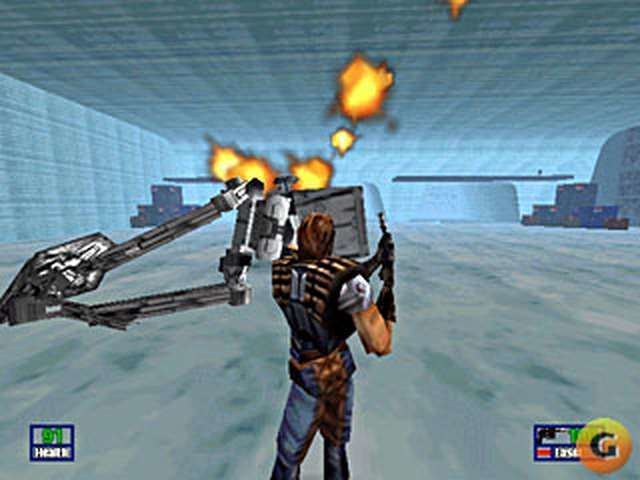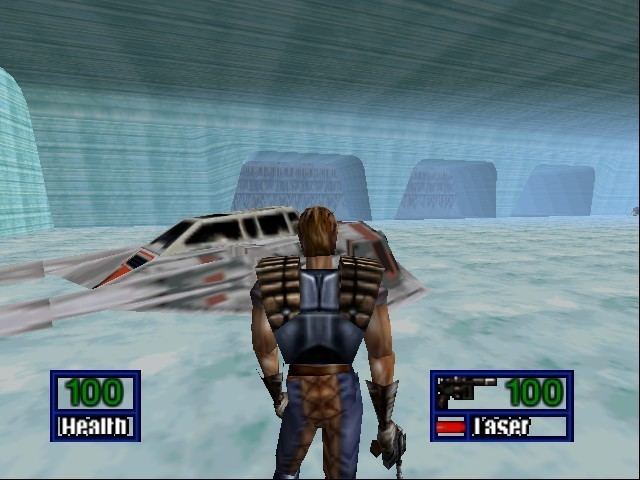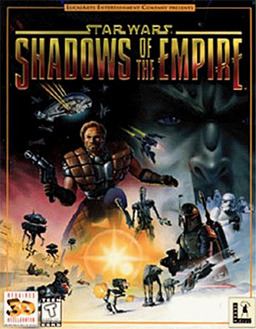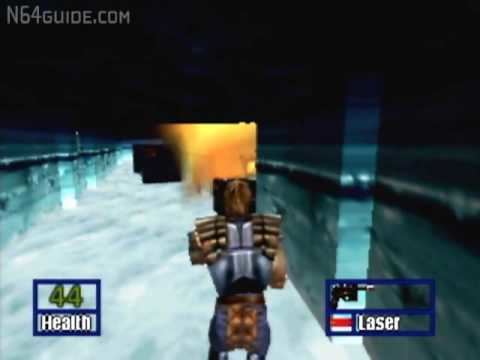7.8 /10 1 Votes7.8
7/10 Steam Designer(s) Jon Knoles Genre Action game | 4.1/5 GOG 4.1/5 Emuparadise Initial release date 3 December 1996 Developer LucasArts | |||||||||||||||||||||||||||||||||
 | ||||||||||||||||||||||||||||||||||
Similar LucasArts games, Shooter games | ||||||||||||||||||||||||||||||||||
Star Wars: Shadows of the Empire is a video game developed and published by LucasArts. Primarily a third-person shooter, the game also utilizes multiple types of vehicular combat sequences. It was released for the Nintendo 64 on December 3, 1996, and a version for Windows 95 was released nearly one year later on September 17, 1997. The game was re-released for Windows systems on May 3, 2016 through Good Old Games. The re-release allows the game to play properly on 64-bit Windows installations.
Contents
In the game, the player controls the mercenary Dash Rendar in his efforts to help Luke Skywalker and rescue Princess Leia from Prince Xizor's hands. It is part of the Star Wars: Shadows of the Empire multimedia project and takes place as a backstory between The Empire Strikes Back and Return of the Jedi. Tracks from the multimedia project's soundtrack are used as the game's musical score. The game received mixed to positive reviews from critics. Shadows of the Empire was the third top-selling Nintendo 64 game for 1997, with more than 1 million copies sold.

Gameplay

Star Wars: Shadows of the Empire plays primarily as a third-person shooter. Players control Dash Rendar, the game's protagonist. Rendar has use of a blaster pistol which recharges after each shot, but the player character can also pick up additional powerups which provide other properties to the gun. In later levels of the game Rendar acquires a jetpack which can be used to traverse larger gaps. The player character has limited health, which can be replenished with health packs located throughout the game. The player is given a finite amount of lives to complete the game. Additional lives can be acquired, however if the player runs out of lives a game over sequence occurs. Each level is timed and up to three challenge point can be received for performing specific actions or finding hidden tokens.

The game also features other, non-shooter elements. In the game's opening level the player controls Rendar as he pilots a snowspeeder in defense of the Rebel base on Hoth. 360 degree space battles occur in which the player character controls the turret of the protagonist's ship, The Outrider. These levels task the player with destroying a specific number of enemy ships. Other space sequences see the player character pilot the ship itself, utilizing its forward cannons to destroy targets. In one sequence the player controls the protagonist during a high speed chase sequence on swoop bikes, hovering bikes which resemble chopper motorcycles. In this sequence the player must both control the swoop and attack and eliminate an enemy gang before reaching the destination.
Plot
The game's story is divided into four chapters. It begins shortly before the battle of Hoth, as Dash Rendar and Leebo, Dashs' droid co-pilot, arrive in Echo Base to deliver supplies. He briefly talks with Han Solo, who gets him temporary clearance to fly with Rogue Squadron. Dash pilots a snowspeeder into battle, but returns to Echo Base when the shield generator is destroyed, just as the Millennium Falcon leaves. He makes his way through the base, attempting to return to his ship, The Outrider. Dash encounters several wampas on the way, and has to fight an AT-ST, but eventually makes it back to Leebo and The Outrider, and they escape through an asteroid field.
Chapter two begins after the end of The Empire Strikes Back, as Dash searches for Boba Fett, who holds Han Solo captive, frozen in carbonite. He hunts down and battles IG-88, who is attempting to repair his ship on Ord Mantell after an altercation with Fett. The droid tells him that Fett is hiding on a moon of the planet. Dash finds Fett, and damages his ship, Slave I, but Fett manages to escape. Believing that The Emperor will let him take Vader's place if Skywalker is killed, Prince Xizor orders Jabba the Hutt to kill Luke Skywalker. Chapter three sees Jabba send a group of swoop bikers to Obi-Wan Kenobi's home, where Luke is practicing his Jedi skills. Dash races them to Kenobi's, and eliminates all members of the gang. Luke informs Dash of a secret imperial supercomputer aboard the Imperial Freighter Suprosa, containing unknown important Imperial construction plans. Dash steals the computer, and battles with a cargo droid in a hangar.
The final chapter begins with Luke, Lando Calrissian, Chewbacca, and Dash infiltrating Xizor's palace on Coruscant to save Princess Leia, whom Xizor has taken captive. Dash enters the palace through the underground sewer system, and battles an enormous dianoga, before entering the palace itself. To stall the mercenary, Xizor summons his gladiator Droid, which Dash quickly disposes of. After defeating the droid, Xizor flees to his Skyhook space station. Xizor's forces engage in battle with the Rebellion, but during the conflict an Imperial star destroyer arrives. The conflict turns as the star destroyer engages Xizor and his forces. Utilizing this distraction, Dash destroys the Skyhook's outer defenses then proceeds to fly inside the station, destroying its core. Dash is presumably killed in the blast, along with Xizor.
A short pre-credits scene shows Luke and Leia on Tatooine, mourning Dash's death. If the game is completed on medium or higher difficulty levels, this is followed by an additional scene of Dash and Leebo, who had managed a jump to hyperspace to escape the blast. Leebo questions Dash's decision to keep the illusion they had died in the Skyhook's destruction, to which Dash says, "It's good to be remembered as a martyr without actually being dead, wouldn't you say?"
Development and release
The work on Shadows of the Empire project started in late 1994 with the idea of making a side story to the movies. After dismissing the use of the main characters from the movies as the star of the new game, which gave the developers more freedom with the game and story they built on a minor character from the book, Dash Rendar. He is a character with many similarities to Han Solo, including a ship, the Outrider, which bears a close resemblance to Solo's Millennium Falcon. Jon Knoles, who was the game's Senior Artist, Animator and previously worked on other LucasArts games for PC and SNES, is credited with bringing the idea of Shadows and placing it between the The Empire Strikes Back and Return of the Jedi films.
LucasArts used the level editor of the Jedi engine, previously used on their games Star Wars: Dark Forces and Outlaws, to create the game's 3D environments. The game was programmed in the language C. The game was originally planned to have 19 levels, Nintendo Power reported a reduction to 12 levels, and the final release contains a total of 10 levels. Mark Haigh-Hutchinson, project lead on Shadows of the Empire, shared his frustrations with working to get the game ready for release shortly after the launch of the Nintendo 64. "Some team members regularly working over 100 hours every week for the best part of a year" he stated. "We had to release our game shortly after launch of the machine, [and so] were under more pressure than might usually have been encountered."
A prototype Nintendo 64 was not yet available when the work began on Shadows, and as a result, the developers used a Silicon Graphics Onyx. Development continued on Onyx hardware for approximately 18 months before near-final hardware was given to the team. Two developers had extensive experience with the SGI platform and prototyped the game using the Performer 3D API. This allowed developers to port the game from the SGI hardware to the Nintendo 64 hardware in only three days. For a prototype controller with which to test the game, they were delivered a modified SNES controller with a primitive analog joystick and Z trigger designed by Konami. For maximal secrecy under strict nondisclosure agreement, the core team was not allowed to speak to anyone else about the hardware or the project, and the controller prototype was concealed within a cardboard box that the team could place their hands into. LucasArts' choice to be an early adopter for the Nintendo 64 came from what they felt were missed opportunities for revenue on consoles.
While in production, Shigeru Miyamoto, Senior Marketing Director of Nintendo, suggested while viewing an early version of the game that the character of Dash be more animated. He suggested Rendar could become restless when waiting for the player to control him, and more animated in how he holds his weapons. Motion capture was done at LucasArts' sister company Industrial Light & Magic (ILM). The recorded animations proved to be unusable, and the animations had to be redone using keyframes. Alias Power Animator was used during this process. Music began using MIDI approximations of the original film scores by composer John Williams. The team felt that MIDI did not appropriately capture the essence of the music, and so digital samples of the original music were used. As part of the Shadows of the Empire multimedia project a full soundtrack was composed by Joel McNeely and recorded with the Royal Scottish National Orchestra. Samples of the soundtrack were used in all versions of the game, with the Windows version containing many of the full tracks. Due to minimal cartridge space the developers sampled the score down to 16-bit at 11 kHz in mono. After some discussion, Nintendo agreed to up the cartridge space from 8MB to 12MB, giving the developers enough room to sample roughly 15 minutes of music on the cartridge. The game is unique among other Nintendo 64 titles for using a digitized orchestral soundtrack, instead of synthesized music like that in Star Wars: Rogue Squadron. John Cygan voices the game's protagonist, Dash Rendar. Cygan reprises his role in Star Wars: X-Wing Alliance. His droid, Leebo, is voiced by Tom Kane. Luke Skywalker is voiced by Bob Bergen, official audio double for Mark Hamill. Prince Xizor, the game's primary antagonist, is voiced by Nick Tate.
Shadows of the Empire was first released on December 3, 1996 for the Nintendo 64, just less than three months after the console's launch. A version for Windows 95 was first released one year later on September 17, 1997. As computers became more powerful an 64-bit architecture became more common the game began to have issues running on these systems. The game was re-released for current Windows systems on May 3, 2016 through Good Old Games. The re-release allows the game to play properly on 64-bit Windows installations.
Release and reception
With the developer reporting more than one million copies sold by 1997, Shadows of the Empire is the third top-selling Nintendo 64 game for that year (September 1996 to August 1997). It has received generally mixed to positive reviews from critics. The main criticism of the game was how its "stunning" first level makes the rest of the game seem like a letdown. GameSpot's John Broady claimed that "...the control, camera angles, and frustrating save feature keep it from reaching its full potential". Allgame's Scott Alan Marriott criticized the shooting sequences as "rather boring, probably due to the less involving third-person perspective".
